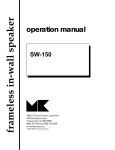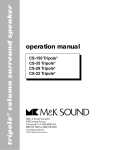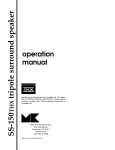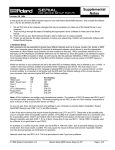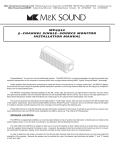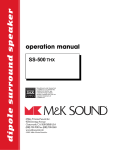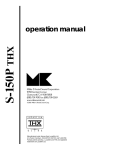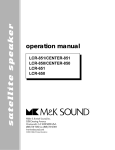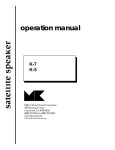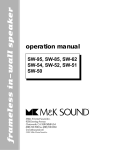Download Miller & Kreisel Sound K-4 Tripole(R) Specifications
Transcript
operation manual SURROUND-55 MkII Tripole® K-4 Tripole® Miller & Kreisel Sound Corporation 9351 Deering Avenue Chatsworth, CA 91311-5858 (818) 701-7010 fax (818) 701-0369 www.mksound.com ©2001 Miller & Kreisel Sound Corp. TRIPOLE® SURROUND SPEAKER TABLE OF CONTENTS 1. 2. 3. 4. 5. 6. 7. 8. 9. 10. 11. 12. 13. INTRODUCTION...........................................................................................................3 THE TRIPOLE SURROUND SPEAKER...........................................................................3 M&K HIGH-FREQUENCY PRISM SYSTEM (Surround-55 Only)...................................3 SPEAKER HOOK-UP........................................................................................................4 INSTALLATION OF YOUR SURROUND SPEAKERS....................................................5 PLACEMENT OF THE TRIPOLE SURROUND SPEAKER........................................6 SPEAKER PHASING TEST......................................................................................8 M&K WALL AND STAND OPTIONS...............................................................................8 SPEAKER DAMAGE & HOW TO AVOID IT....................................................................8 CABINET MAINTENANCE..............................................................................................9 IF YOU NEED SERVICE..................................................................................................9 M&K 10 YEAR WARRANTY..........................................................................................10 SPECIFICATIONS.........................................................................................................10 DIAGRAMS FIGURE 1 FIGURE 2 FIGURE 3 FIGURE 4 FIGURE 5 FIGURE 6 FIGURE 7 FIGURE 8 FIGURE 9 FIGURE 10 WIRING WITH THE SURROUND SPEAKER.................................................4 BRACKET & SPEAKER ORIENTATION...........................................................6 SURROUND SPEAKER PLACEMENT (ONE ROW OF LISTENERS)...........6 SURROUND SPEAKER PLACEMENT (TWO ROWS OF LISTENERS)........6 SURROUND SPEAKER PLACEMENT (REAR WALL).....................................6 MULTIPLE SURROUND SPEAKERS..............................................................7 ST-SERIES WALL BRACKET OPTIONS............................................................8 ST-SERIES STAND AND LDM OPTIONS...........................................................8 SURROUND-55 FLUSH MOUNT BRACKET TEMPLATE.................................11 K-4 FLUSH MOUNT BRACKET TEMPLATE..................................................12 2 TRIPOLE® SURROUND SPEAKER 1. INTRODUCTION Congratulations! Your new M&K Tripole® speaker will give you years of unmatched enjoyment and excitement while listening to your favorite multichannel musical and audio/video sources, whether they are Dolby Digital, MLP, DTS, Pro-Logic, or enhanced stereo modes. We encourage you to read this owner’s manual, as there is a great deal of information provided here to help you get the best possible performance. If you have any questions about your speaker system, please contact your M&K dealer or call the M&K factory directly at (818) 701-7010, from 8:30 AM to 5:00 PM Pacific Time, Monday through Friday. We will be happy to help you with any question. Additional information may also be obtained on our web site www.mksound.com or you may send us an e-mail to [email protected]. 2. THE TRIPOLE® SURROUND SPEAKER M&K’s exclusive Tripole® design is a new concept in surround channel speaker design, offering the performance aspects of two different types of speakers. Think of it as a dipole surround speaker that includes a very high quality direct radiating speaker in the same cabinet. As a Tripole, the front baffle drivers (direct radiator) operate full range. The side Dipole drivers also operate, so sound is radiated on three axes. This means that the speaker can simultaneously produce a directional stereo image in the surround channels and an enveloping sound that wraps around the listeners. The directional qualities and stereo imaging may be preferred for playing back the "split" (stereo) surrounds of 5.1 channel discrete digital recordings. The Tripole® design is also ideal for the back surround channel of a Surround-EX 6.1 system. If you have such a system, we recommend using two Tripole® surround speakers to reproduce this channel. 3. THE M&K HIGH-FREQUENCY PRISM SYSTEM (Surround-55MkII Only) Your Surround-55MkII Tripole® speaker utilizes M&K's exclusive High-Frequency Prism System to optimize imaging and coverage of sound throughout the listening area. This system is designed to take into account the effect of the curved mesh metal grilles on your speakers. Therefore, your Surround-55s are designed for the best sound when the grilles are in place. We recommend that you leave the grilles on the speakers for all listening. You will note that the tweeter in your Surround-55MkII speakers is mounted at a slight angle (4.7 degrees). This mounting is an integral part of the High-Frequency Prism System. When the speakers are mounted properly, the tweeter will be angled away from the listening position. That means that the surround channel speakers should be mounted with the tweeter angled towards the back wall of the room (when the speakers are mounted on the side walls), and with the tweeter angled toward the closest side wall (when the speakers are mounted on the back wall of the room). When the speaker is mounted in this fashion, its stereo imaging and coverage of sound are optimized for a very wide listening window that extends from the on-axis position towards the center of the room. If the speaker is mounted with the tweeter pointed in the other direction, its sound quality will be adversely affected. NOTE: When the speaker is mounted above the listeners’ heads, make certain that the tweeter on the front baffle is at the bottom. 3 TRIPOLE® SURROUND SPEAKER FIGURE 1 4. SPEAKER HOOK-UP LEFT CHANNEL SPEAKER / RIGHT CHANNEL SPEAKER Your surround speakers come in two versions - a Left Channel speaker and a Right Channel speaker. It is critical that the correct speaker be used in each channel. On the back panel of the speaker, there is an arrow with the printed nomenclature "Point Arrow Towards Screen." To correctly install the Tripole® surrounds, be sure that the arrow printed on each speaker is pointed towards the television screen. The arrows will not be visible once the speaker is installed. To confirm that the Surround-55 speakers are correctly installed, check the angle of the tweeter (see Section 3 above). The tweeter for each speaker should be pointing towards the back wall (or the nearest side wall). WIRING THE SURROUND SPEAKER The Positive ( + ) lead from your amplifier or receiver should be connected to the RED ( + ) "INPUT" terminal, and the Negative ( — ) lead from your amplifier or receiver should be connected to the BLACK ( — ) "INPUT" terminal. See Figure 1. SPEAKER WIRE The sound quality that you get from your speaker can be affected by the type of speaker wire that you use to connect them. While it is possible to use speaker wire as thin as 22 gauge to hook your surround speaker up, wire of less than 16 gauge will compromise their sound quality. For wire runs of up to 10 feet, 16 gauge wire is acceptable. For runs up to 20 feet, you should use a minimum of 14 gauge. For up to 30 feet, use a minimum of 12 gauge, and over 30 feet should use 10 gauge. The smaller the gauge number, the thicker the wire. There are a wide variety of premium speaker cables available from a number of specialist manufacturers. We do not endorse any specific brand of premium cable, but we do recommend the highest quality cable that fits your budget. Beware, though -- with cables, expensive is not always better. If you have any questions, contact your M&K dealer for advice. 4 TRIPOLE® SURROUND SPEAKER 5. INSTALLATION OF YOUR SURROUND SPEAKERS Your M&K Tripole® surround speaker can be installed in a variety of ways. Choosing the correct location, however, is extremely critical. READ SECTION 6 (page 6) BEFORE DECIDING WHERE TO INSTALL YOUR SURROUND SPEAKER. They can be placed on tall stands (such as the M&K ST series or LDM stands, which are available from your M&K dealer); they can go on shelves or bookcases; or more permanently mounted using brackets or a ceiling suspension system. FLUSH-MOUNT WALL HANGER BRACKETS Your surround speakers come with a flush-mount wall bracket that can be attached to each cabinet. There are pilot holes for mounting the brackets on the back baffle of the speaker. Also included are the matching brackets that attach directly to the wall, as well as all necessary mounting screws and drywall inserts. In order to use these brackets, see the enclosed template and follow these instructions. Attach the brackets to the speaker using the enclosed 3/4" wood screws. You will have to remove the 3/8" bolt installed in the back of the speaker. Use the pilot holes at the top center of the back baffle of the cabinet. Either of the matching brackets can be attached to the speaker. The bracket that attaches to the speaker must point down, and the bracket that attaches to the wall must point up. In both cases, the face with the printing must face out. Then determine where you will locate your surround speakers. See Section 6 below for guidelines on where to locate the speakers. Then, using the template sheet enclosed (which is reproduced on the next page), mark holes on the wall where the brackets will be permanently mounted. Ideally, one set of these holes should go into a wall stud, to give you the greatest strength. First, locate the center of the stud. Tape the four corners of the template sheet to the wall in the location you have selected, using a carpenter's level to make sure the line marked "LEVEL TEMPLATE TO THIS LINE" is level. The template sheet has locations marked for the two mounting holes needed to attach the wall bracket to the wall. Once you are absolutely certain that you have the correct location, you are ready to drill the pilot holes. Go ahead and drill right through the paper template into the wall. Re-check your measurements (especially making sure the holes will be level) at least once before drilling. WARNING: IT IS POSSIBLE THAT ELECTRICAL WIRING MAY BE LOCATED BEHIND THE WALL IN THE LOCATION THATYOU HAVE SELECTED. BE EXTREMELY CAREFUL ANY TIME YOU DRILL INTO A WALL. If you are mounting the bracket to a wall stud, drill two 3/32" holes per bracket. Remember that the wallboard material is 1/2" or 5/8" inches thick, and you will drill through this before meeting the stud. If you are mounting the bracket to drywall with the plastic anchors, drill two 1/4" pilot holes per bracket. Once all holes have been drilled, remove the template from the wall. Press the plastic wall anchors into the 1/4" pilot holes until they are flush with the wall. Tap them gently into place if necessary. Once the holes are drilled, place one bracket against the wall, making sure that the "tongue" (the portion that will engage the bracket on the speaker cabinet) is facing away from the wall and pointing up. Using the two #6 - 1 3/4" wood screws provided, fasten this bracket to the wall. BE VERY CAREFUL. DO NOT FORCE THE PLASTIC ANCHORS THROUGH THE WALL OR OVERTIGHTEN THE SCREWS. Install the second bracket in the same fashion. That's it! All that is left for you to do is attach the speaker wire to the input terminals (Section 4), and, from the top, gently slide the speaker into place against the wall. Do the same for the other channel. 5 TRIPOLE® SURROUND SPEAKER FIGURE 2 6. PLACEMENT OF THE TRIPOLE® SURROUND CHANNEL SPEAKER A B When the speaker is mounted above the listeners’ heads, make certain that the tweeter on the front baffle is at the bottom. See Figure 2. Your Tripole® surround speakers are specifically designed to be used as surround channel speakers in a multichannel audio system (either Home THX or non-THX). The instructions given here apply to surround channel applications, including Dolby Digital, MLP, DTS, and multichannel music modes such as ambience recovery or acoustical environment synthesis. (A) Position the bracket on the speaker as pictured when the speaker is to be located above the listeners’ear level. (B) Proper orientation of the front of the speaker when it’s located above the listeners’ear level.Notice the tweeter is located towards the bottom of the baffle. FIGURE 3 Your surround speakers can be installed in a wide variety of locations, but in some rooms their installation can be quite a challenge to install. In general, the surround speakers should be located high on the walls and either to the sides or behind the listening position. If you have questions, please contact your M&K dealer or the M&K factory. a. POSITION RELATIVE TO SEATING The surround speakers should be located adjacent to the seating position. If there is one row of seats, the Tripole® surround speaker should be located directly to the left and to the right of this row of seats. See Figure 3. If there are multiple rows of seats, then the Tripole® surround speaker should be located directly to the left and right of the geometric center of the listening area. See Figure 4. FIGURE 4 If the surround speakers cannot be located exactly adjacent to the seating area, it is better for them to be located slightly towards the back of the room, behind the listening positions, rather than in the front of the room, between the listening position and the screen. It is also acceptable to locate the speakers on the back wall of the room. In this case, they should be located symmetrically relative to the back corners. See Figure 5. Another good location is in the corner itself. In addition to the flush mount brackets provided with your speakers, M&K makes a variety of very high quality speaker mounting brackets that can be used to mount the speakers to the side or back walls, as well as in the corner itself. FIGURE 5 b. HEIGHT In general, the surround speakers should be located near the ceiling. Placement above the 6 TRIPOLE ® SURROUND SPEAKER FIGURE 6 listeners' heads is very important, with the cabinet's bottom at least two feet above a seated listener's head. In fact, if at all possible, the speakers should be located above a standing listener's head, approximately 6 to 7 feet off the floor, so that people walking around the room will be unable to localize them. c. WALL LOCATION The surround speakers can be mounted on either the side walls or on the back wall, or even directly in a corner. They can be flush on the wall, on shelves, on brackets, etc. The Tripole’s® great flexibility makes it very forgiving of room placement that is less than optimum. The Tripole® will give you a combination of an enveloping sound with directionality. You will hear directional effects, and even imaging when the recording has these qualities. yet at the same time, you will also hear a diffuse sound from the Dipole drivers mounted on the left and right cabinet baffles. If the sound lacks the directionality you desire, point the front baffles directly at the main listening position. Either M&K ST-wall brackets or Omnimount® brackets are very useful for this. If the sound is too directional, angle the speakers towards the back wall or the side wall surface directly behind them. By reflecting sound behind the listening position, you may increase the sense of envelopment in the sound. d. USING MULTIPLE PAIRS OF SURROUNDS Some listeners prefer multiple pairs of surround speakers. In very large rooms, this may even be necessary. Also, some surround processors and receivers have both side and rear surround channel outputs. Multiple pairs of surrounds can make a dramatic improvement and provide a deeper and broader surround effect. When using multiple pairs of surround speakers, a symmetrical installation pattern works best. For example, one pair could be mounted on the back wall of the room, mounted equidistant from the back corners, wit the other pair mounted on the side walls of the room, equidistant from the same back corners. e. USE WITH SURROUND-EX AND OTHER 6.1 CHANNELS SYSTEMS When using the Tripole® surround speaker with a 6.1 channel system, we strongly recommend using two speakers to reproduce the back surround channel. See Figure 6. These speakers should be mounted on the 7 TRIPOLE ® SURROUND SPEAKER center area of the back wall, symmetrical to the wall’s center line. Follow your processor or receiver’s instructions for proper calibration. FIGURE 7 Note: Under ideal conditions, the back surround speakers should be located between 30-45 degrees behind the listener. See Figure 5. In some listening situations, this may not be possible. Please experiment with various locations within your listening situation to locate the optimum location for the back surround speakers. If you have any additional questions, please contact your M&K dealer or M&K factory directly. If you are using this speaker for the rear surround channel of a Surround-EX system, the speakers should be mounted so that the arrows point towards each other (towards the center). 7. SPEAKER POLARITY TEST In any system using a subwoofer separate from Satellite speakers, especially in multichannel surround sound applications, a polarity test must be performed to insure proper phase in the system, thereby achieving optimum sound in the critical bass frequencies. We recommend using a test disc to test the phase of all the channels. Test by comparing the phase of the channels until you have established that all channels have identical polarity. 8. M&K WALL AND STAND MOUNTING OPTIONS FIGURE 8 ST- STAND OPTION We recommend our M&K’s ST-Wall brackets, for the greatest greater flexibility in mounting your surround speakers. A version designed for corner mounting, known as the ST-Corner/Tilt is also available. See Figure 7. Another option for the Surround-55 is a wall mount bracket that allows the speaker to be mounted flush to the wall. This type of mount can work quite well, however it does limit the ability of the speaker to be rotated or aimed. For the K-4 Tripole® Surround speaker, we recommend using our ST-BT5 wall bracket. If wall mounting is not ideal for your particular application, M&K also offers the LDM and ST series of floor mount stands for the surround speaker. See Figure 8. 9. SPEAKER DAMAGE & HOW TO AVOID IT An important factor to consider with any loudspeaker system is the potential for speaker damage. Even though your surround speakers have extremely high power handling ability, they still can be damaged by relatively low powered amplifiers. PEDESTAL STAND OPTIONS TRIPOLE® SURROUND SPEAKER While very few M&K Satellites are actually returned for service, the vast majority of those returned are not for manufacturing defects. Instead, they are returned because they have been overdriven, almost always because the amplifier or receiver used was driven into clipping distortion. This damage is considered abuse, and is not necessarily covered under warranty. This clipping distortion occurs when the demands of the music are greater than the amplifier's available power. It can occur at 20 watts with a small amplifier, or at 400 watts with a large amplifier. Regardless, when this happens, the amplifier's output waveform (which usually looks like a smooth arc) is "clipped" off, exhibiting a flat top instead of the arc. This flat top contains multiples of the original amplified frequencies, sometimes at higher levels than the original signal itself. For tweeters, this can be very damaging, as this distortion is well above the audible range, where you will be unable to hear it, and where the tweeter is more vulnerable to damage. When an amplifier clips, its sound becomes harsh and grating, and a break-up is often audible in the bass frequencies. It will become uncomfortable to listen to, compared to a slightly lower volume level. When you are listening at high volume levels, be aware of the onset of clipping distortion, and turn the volume down slightly if the sound takes on the character described above. When tone controls or equalizers are used to boost frequencies, the problem occurs much more rapidly. Even a small boost of low or high frequencies can easily double the power requirement and lead to amplifier clipping at moderate levels. Therefore, you should use your tone controls judiciously, avoiding extreme boosts of the bass and treble controls, especially when you are listening at high volume levels. The best way to avoid speaker damage is to use common sense. Use moderate boosts of tone controls or equalizers, at the very most. Listen carefully for any harshness and break-up, especially at high volume levels, and turn down the volume when needed. If you cannot get enough volume, you may need to consider a higher-powered amplifier. If you have any questions about this, please contact M&K, and we will be happy to discuss it with you further. 10. CABINET MAINTENANCE Treat the cabinet as you would any piece of fine furniture. Its black vinyl finish does not require any special maintenance; regular dusting with a lint-free cloth and periodic cleaning is all that is required. Do not use any solvent based cleaners, as they may damage the cabinet surface. 11. IF YOU NEED SERVICE Contact your dealer or M&K with a complete description of the problem. Please have the unit's model and serial numbers (found on the back of the cabinet), date of purchase, and your dealer's name. You can call M&K between 8:30 AM and 5:00 PM Pacific Time, Monday through Friday, at (818) 701-7010. If you call outside these hours, leave a message, and we will return your call. Alternatively, you may send us an e-mail to [email protected]. DO NOT RETURN YOUR SPEAKERS TO THE FACTORY FOR SERVICE WITHOUT OBTAINING PRIOR AUTHORIZATION. TRIPOLE® SURROUND SPEAKER 12. M&K 10 YEAR WARRANTY All M&K speakers (except for subwoofers) carry a ten year limited parts and labor warranty. This warranty is transferable to new owners. It does not cover abuse, misuse, repairs by unauthorized service stations, speakers without serial numbers, and those damaged in shipping or by accident. If you have any questions about the warranty, please contact M&K. 13. SPECIFICATIONS SURROUND-55MkII Tripole® IMPEDANCE: MINIMUM POWER: RECOMMENDED POWER: MAXIMUM POWER: FREQUENCY RESPONSE: DIMENSIONS: WEIGHT: DRIVERS: 4 ohms 25 watts RMS 50 watts RMS to 200 watts RMS 200 watts RMS unclipped peaks 87 - 20 KHz (± 3dB) 10 3/16” x 6 7/8” x 8 1/4” (HWD) 12 lbs. 1 1” Tweeter 1 5 1/4” Mid/Woofer 2 3” Mid/Tweeters K-4 Tripole® IMPEDANCE: MINIMUM POWER: RECOMMENDED POWER: MAXIMUM POWER: FREQUENCY RESPONSE: DIMENSIONS: WEIGHT: DRIVERS: 4 ohms 25 watts RMS 50 watts RMS to 150 watts RMS 150 watts RMS unclipped peaks 100 - 20 KHz (± 3dB) 7 3/8” x 6” x 6 3/8” (HWD) 6 lbs. 1 1” Tweeter 1 4” Mid/Woofer 2 2.5” Mid/Tweeters FIGURE 9 FIGURE 10 Surround-55MkII/K-4 Tripole 06/14/01 pt/qrk PN # 70004












